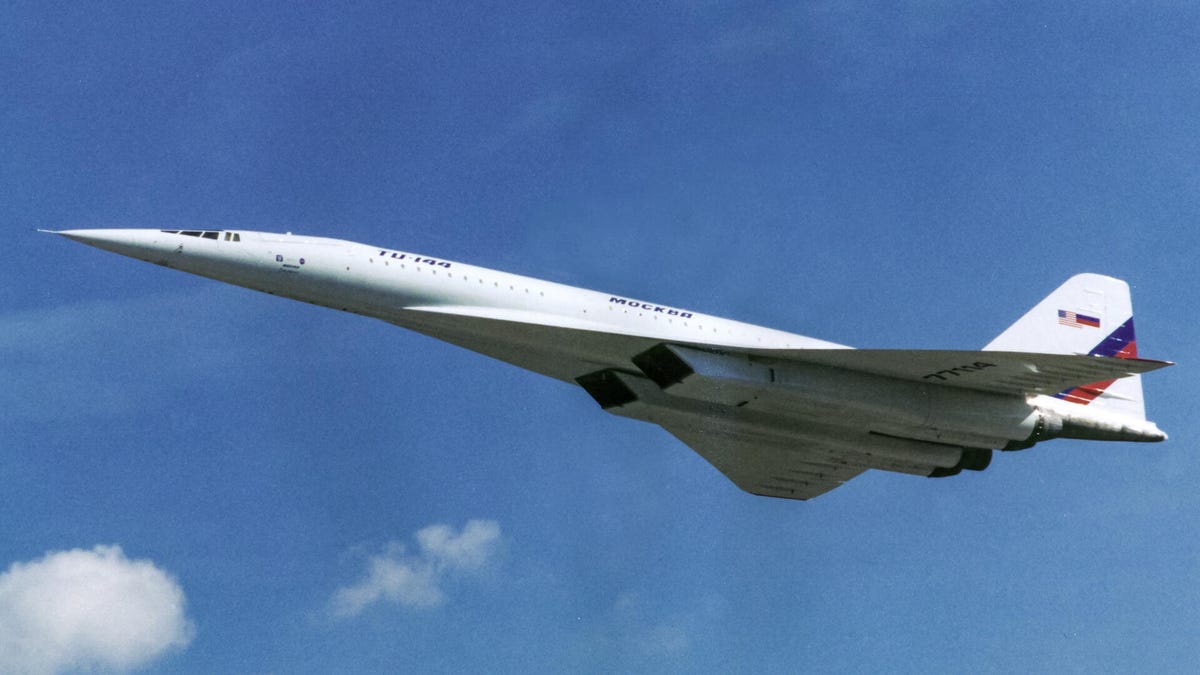Tupolev Tu-144: Inside Russia's supersonic airliner
Bigger and faster than the Concorde, here's a look inside Russia's ill-fated supersonic airliner.

Russia's Concorde
The Russian-built Tupolev Tu-144 was the world's only other supersonic airliner besides the Anglo-French Concorde. It first flew on Dec. 31, 1968, beating the Concorde into the sky by two months. During the Cold War it was a notable achievement for the then-Soviet Union.
Concorde's cousin
With delta wings and a sleek fuselage, the similarities between the Tu-144 and the Concorde are quite evident.
Interesting company
A closeup of the Tu-144's droop nose, with another Tu-144 behind with the nose retracted. Even more interesting is what's behind that: A Tu-95 Bear bomber. In the far distance is a trio of Il-76s.
Nose
Like the Concorde, the droop nose improved visibility for the flight crew during landing and when the aircraft was on the ground.
New life
The Tu-144LL flying laboratory outside its hanger at the Zhukovsky Air Development Center (now the Gromov Flight Research Institute) at the start of its new life as a research aircraft.
Takeoff
The Tu-144LL takes off from Zhukovsky.
Flare
The Tu-144LL just about to land.
Fast landing
The modified Tu-144 touching down near Moscow in 1997, with its three drag parachutes that were required for landing.
Taxi
Taxiing after a test flight.
Tu-144 brochure
An Aeroflot brochure about the Tu-144. Between 1977 and 1978, the Tu-144 made just 55 passenger flights.
Page turner
Note the small seats.
Tu-144 @ Sinsheim
A Tu-144 arrives at Germany's Technik Museum Sinsheim in 2001.
Sinsheim Technik Museum
The only Tu-144 you can tour outside of Russia. It's the only place in the world you can see one next to a Concorde.
We toured both, and the rest of the museum. For that story, check out Civilian supersonic: Exploring Russia's Tu-144 and the Concorde at the Technik Museum Sinsheim.
Bigger cousin
The Tu-144 is a little chubbier and blockier than the Concorde.
Not taking flight
Many of the aircraft at the museum are fully accessible, though they're mounted at an angle, which makes exploring them quite... interesting.
Short service
Epically unreliable, the Tu-144 only carried passengers in the years between 1975 and 1978 -- and then rarely.
Canard closeup
Under the canards and droop nose.
Brutes
The Kolesov RD-36-51 engines were beasts, capable of 45,000 pounds (246 kN) of thrust each. The Tu-144 could fly higher and faster (Mach 2.15 vs Mach 2.04) than the Concorde.
Thirsty
Earlier Tu-144s used even more powerful, but far thirstier, Kuznetsov NK-144 engines, limiting range severely.
Into the blue
The Tu-144 had plenty of faults -- it was difficult to handle, and noisy in the cabin during flight -- but given the limited resources and more rudimentary technology, it's impressive it worked at all.
CCCP
The Tu-144 wasn't flown to the museum; it arrived from Moscow via barge and truck.
Now boarding
You enter and exit at the very rear of the aircraft. When in service, this was storage.
Inside!
Having been long been fascinated by this plane, getting to go inside was a big thrill for Geoff, who toured the museum for CNET. The angle was quite steep and it's hot inside, so it's quite a climb up to the cockpit.
Windows 3.1
These are easily the smallest windows Geoff had ever seen on a passenger aircraft. Smaller even than those on the Concorde, which are already pretty small. A paperback book would cover them.
Roomier
The 144 was enough wider than the Concorde to have a three-two seating layout, accommodating up to 140 passengers (20 more than the Concorde). Most of the seats have been removed to make it easier for visitors to move around.
Seats
Not that the Concorde seats are too impressive either, but these don't look like what you'd expect to find on a supersonic airliner.
3 up front
Like most airliners of the era, it had a crew of three.
Engineer
The flight engineer station, with duplicate throttles.
Supersonic sisters
Check out Civilian supersonic: Exploring Russia's Tu-144 and the Concorde at the Technik Museum Sinsheim and Before the Concorde, there was 'the Concordski' for more about the museum and this amazing aircraft.

